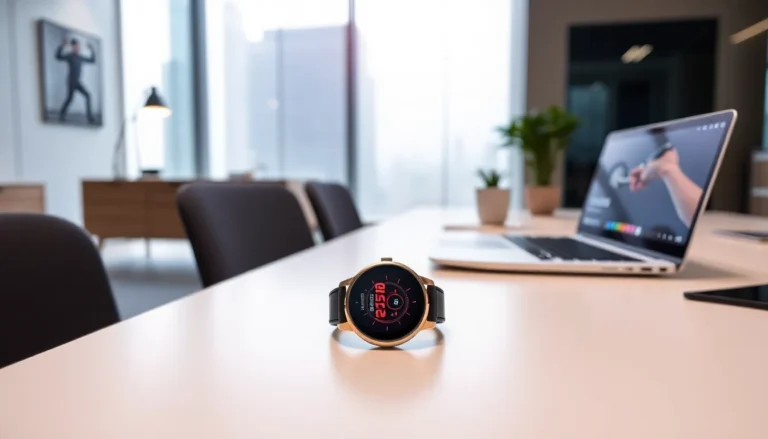Imagine a world where your thoughts flow seamlessly from your mind to your device, all without lifting a finger. Welcome to the age of dictation on wearables, where smart technology meets effortless communication. Gone are the days of awkwardly typing out messages while trying to balance a coffee cup and dodge oncoming traffic. Now, with just a few words, you can send a message, jot down a note, or even schedule that dentist appointment you’ve been avoiding.
Wearables are revolutionizing how we interact with technology, making dictation not just convenient but downright fun. With voice recognition getting smarter every day, it’s like having a personal assistant strapped to your wrist. So, buckle up and get ready to discover how these nifty gadgets can transform your daily grind into a hands-free experience that’s both productive and entertaining. Who knew talking could be this efficient?
Table of Contents
ToggleOverview of Dictation on Wearables
Dictation on wearables provides users with a seamless way to communicate. Many users take advantage of voice recognition technology for tasks like messaging and note-taking. This technology reduces the reliance on manual typing, allowing for quick responses. Enhanced voice recognition capabilities contribute to the growing efficiency of these devices.
Voice-activated features enable users to schedule appointments easily. Applications integrated with wearables offer diverse functionalities, from health tracking to various reminders. These capabilities transform how individuals interact with their devices, making processes like setting timers or sending texts effortless.
Devices supporting dictation often come with improved accuracy, adapting to various dialects and speech patterns. Companies continuously develop algorithms that improve speech recognition in different environments, enhancing user experiences. Users can dictate messages even in noisy settings without compromising clarity.
Wearables equipped with dictation capabilities are popular in professional settings. Many professionals leverage this technology to streamline workflow and increase productivity. Employees can manage tasks hands-free, integrating dictation into their daily routines effectively.
Tech advancements drive the integration of artificial intelligence, enhancing the understanding of user intent. Enhanced contextual understanding allows wearables to execute commands with greater precision. Manufacturers focus on user-friendly designs that facilitate voice commands, ensuring accessibility for all users.
Overall, dictation on wearables signifies a shift in how technology interacts with users. As advancements continue, this feature will likely become an essential component of daily technology use.
Advantages of Using Dictation on Wearables

Dictation on wearables offers numerous benefits for users seeking convenience and efficiency in their daily tasks.
Hands-Free Convenience
Hands-free convenience stands out as a primary advantage of dictation on wearables. Users send messages without fumbling with devices, simplifying communication while on the move. Voice commands replace manual input, allowing users to interact with technology seamlessly. Multitasking becomes easier, as tasks like sending texts or taking notes can occur while driving or exercising. Wearables also accommodate users in noisy environments, ensuring clarity regardless of background sound. This hands-free approach enhances productivity and fosters a more enjoyable experience while engaging with technology.
Enhanced Efficiency
Enhanced efficiency arises through quicker task management with dictation features. Users can schedule appointments or set reminders in real-time, eliminating delays associated with typing. Immediate access to voice notes allows for speedy documentation of ideas and thoughts. Employing intelligent voice recognition accurately understands commands, further streamlining processes. As a result, daily responsibilities transform into manageable activities completed in moments. Wearable devices significantly elevate overall effectiveness by simplifying interactions and minimizing distractions, making users more productive than ever.
Challenges in Implementing Dictation on Wearables
Dictation on wearables presents unique challenges. Accuracy issues often arise due to background noise or multiple speakers. Sound clarity can affect voice recognition capabilities, leading to misinterpretations. Users frequently experience frustration when the device fails to recognize commands accurately, especially in crowded environments.
User interface limitations further complicate the experience. Many wearable devices feature small screens which restrict navigation during dictation. Simplifying commands is crucial for usability, yet many interfaces lack intuitive designs. Difficulty arises when users attempt to access additional features or settings while dictating. Enhancements are necessary to support smoother interactions and improve overall satisfaction with voice commands.
Popular Wearable Devices Supporting Dictation
Wearable devices increasingly support dictation features, enabling users to communicate effectively in various settings. Smartwatches and fitness trackers lead the trend in enhancing hands-free productivity.
Smartwatches
Smartwatches recognize speech with impressive accuracy, making them ideal for dictation tasks. Numerous models, such as the Apple Watch Series 8 and Samsung Galaxy Watch 5, allow users to send messages, take notes, and set reminders using voice commands. In addition, voice assistants like Siri and Google Assistant integrate seamlessly into these devices, offering a more natural interaction. Users appreciate how they can quickly respond to texts while on the go. The compact format and built-in microphones provide convenience, ensuring clarity even in busy environments.
Fitness Trackers
Fitness trackers like Fitbit Charge 5 and Garmin Venu Sq also incorporate dictation capabilities, enhancing users’ experience while maintaining focus on health goals. These devices help users log workouts and set fitness-related reminders through voice input. Voice recognition allows users to dictate notes on workout performance hands-free. Integration with mobile applications streamlines the transition from dictation to data management, ensuring efficient tracking. Users benefit from the seamless convenience of combining fitness monitoring with effective communication.
Future Trends in Dictation Technology on Wearables
Emerging trends in dictation technology on wearables are visible in several key developments. Integration of artificial intelligence enhances speech recognition accuracy, allowing for more precise command acknowledgment. Voice processing algorithms improve contextual understanding, making it easier for devices to comprehend complex requests.
Enhanced personalization is another significant trend. Users can expect dictation systems to adapt to their speech patterns and preferences over time. Refinements in natural language processing will ensure fluent interactions that mirror natural conversation.
Adoption of multi-modal interfaces may also gain traction. Users might switch seamlessly between voice commands and touchscreen inputs, creating a more versatile experience. This approach allows for complex tasks to be completed when voice recognition faces limitations.
Improvements in hardware are equally critical. Newer wearable devices may feature advanced microphones designed to capture voices clearly, even in noisy environments. Increased processing power will support real-time transcription, ensuring users receive immediate feedback.
Further developments could see wearables becoming more deeply integrated with smart home technology. Dictation functions may control lights, appliances, or security systems entirely through voice. This integration enhances the hands-free experience, making technology truly responsive to users’ commands.
Moreover, growth in health management applications is expected. Users might dictate health-related notes directly into their wearable devices, tracking symptoms or medication schedules hands-free. This capability can empower users to better manage their health in real time.
Overall, the future of dictation technology on wearables holds promise. With advancements in AI, interface design, and hardware improvements, dictation will soon become an even more vital tool in daily life.
Dictation on wearables is reshaping how users interact with technology. The hands-free convenience and enhanced productivity it offers are invaluable in today’s fast-paced world. As advancements in voice recognition and artificial intelligence continue to evolve, wearables will become even more integral to daily tasks.
The seamless integration of dictation features into devices like smartwatches and fitness trackers highlights their potential to streamline communication and task management. While challenges remain, the future looks promising with innovations aimed at improving accuracy and user experience.
As these technologies develop, users can expect a more intuitive and personalized interaction with their devices, making dictation a fundamental aspect of modern life.









